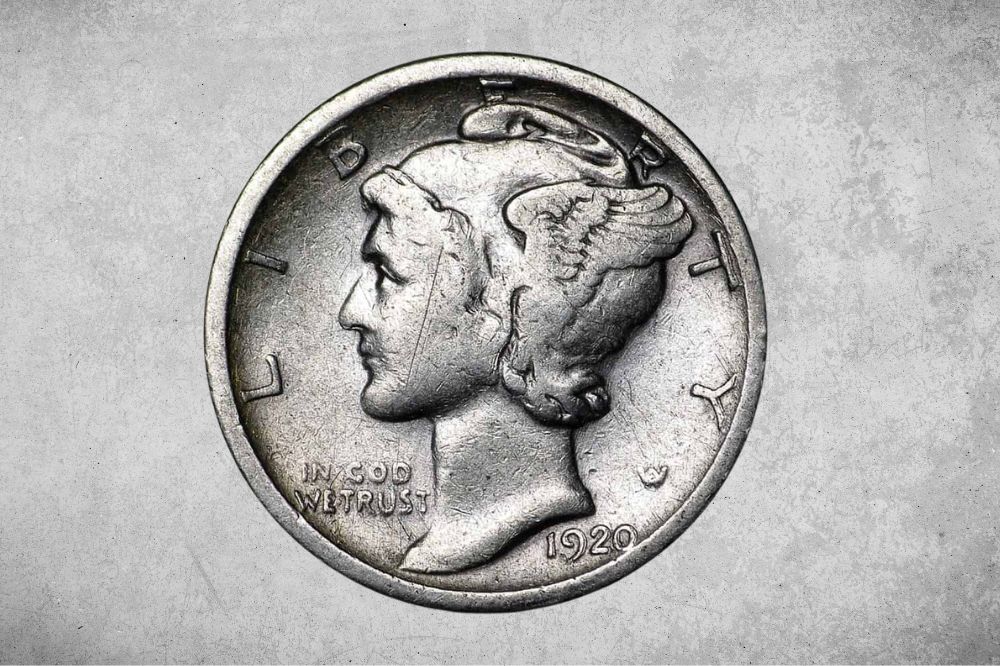Are you interested in the value of the 1920 dime?
The 1920 Dime is another valuable piece of American history worth exploring. The coin is part of the Mercury dime series, introduced by the US mint in the early 20th century. While these coins are relatively common, many are in a terrible state because they were heavily circulated.
For this reason, many coin collectors will pay huge sums of money for the few existing coins in pristine condition or mint state. This holds, especially for numismatists who would love to put a complete set of Mercury silver coins.
In this article, we will discuss the various aspects of the 1920 dime, including its design details, value, history, grading, etc.
1920 Dime Details
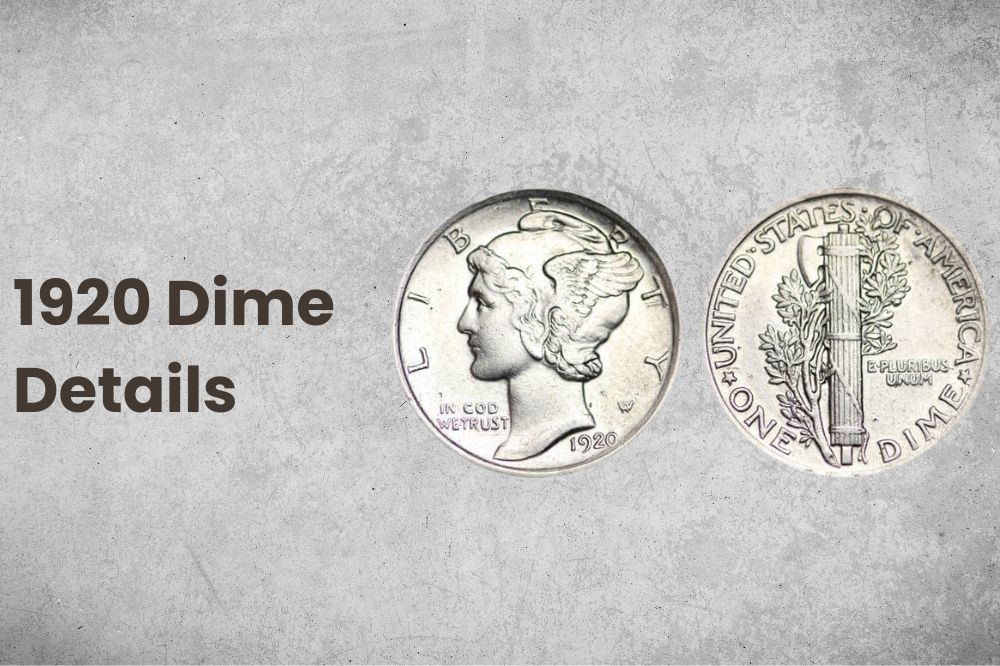
- Category: Mercury Dimes
- Mint: 92,021,000
- Designer: Adolph A. Weinman
- Metal Composition: 90% Silver, 10% Copper
- Fineness: 9
- Diameter: 8mm
- Weight: 5g
- ASW: 0723oz
- Edge: Reeded
With an aesthetically pleasing design and beautiful glistening luster, the 1920 dime is a must-have specimen. It’s composed of 90% silver and 10% copper, which gives it a unique shine. It also features a reeded edge for easier grip and to prevent counterfeiting.
The Obverse Side
The obverse side depicts Lady Liberty facing left and wearing a cap with wings on her head. Coin collectors believe the Winged Liberty symbolizes freedom of speech. However, some believe the portrait represents the Roman god of translators and interpreters–Mercury, hence the name Mercury Dime.
The word LIBERTY appears around the periphery, while IN GOD WE TRUST is engraved on the right side of Lady Liberty’s head. On the left side, you will notice the Engraver’s initial AW – Adolph A. Weinman. And just below the neck, the date 1920 appears.
Although all 1920 dimes share a similar design, a few might have a weak strike. As a result, a few design details might not appear as sharp or clear as expected. The same applies to polished or cleaned coins.
The Reverse Side
For the reverse side, the designer incorporated a war motif–more specifically, the Roman Fasces. This is the Latin name for a bundle of rods tied together using a strap and enclosing an axe, with its head popping outside.
In ancient Rome, leaders used fasces as a symbol of authority and power. Therefore, it makes sense to include such a significant symbol in an iconic coin. On both sides, the fasces is flanked by olive branches to symbolize unity and peace.
The word E PLURIBUS UNUM appears on the left side, whereas UNITED STATES OF AMERICA and ONE DIME, encircle the fasces.
Like the heads, the tails of the 1920 dime might have several design variations. Some might have fully visible details, while others might have split bands or no band at all. Regardless, these variations could influence the coin’s overall value.
1920 Dime Value Chart
| Mint Mark | Good | Fine | Extremely Fine | Uncirculated |
| 1920 “no mint mark” Dime | $3.4 | $3.9 | $8.6 | $18 |
| 1920 “S” Dime | $3.7 | $6.1 | $21 | $52 |
| 1920 “D” Dime | $3.4 | $5.1 | $24 | $52 |
1920 Dime Value and Varieties Guide
1920 “No Mint Mark” Dime Value
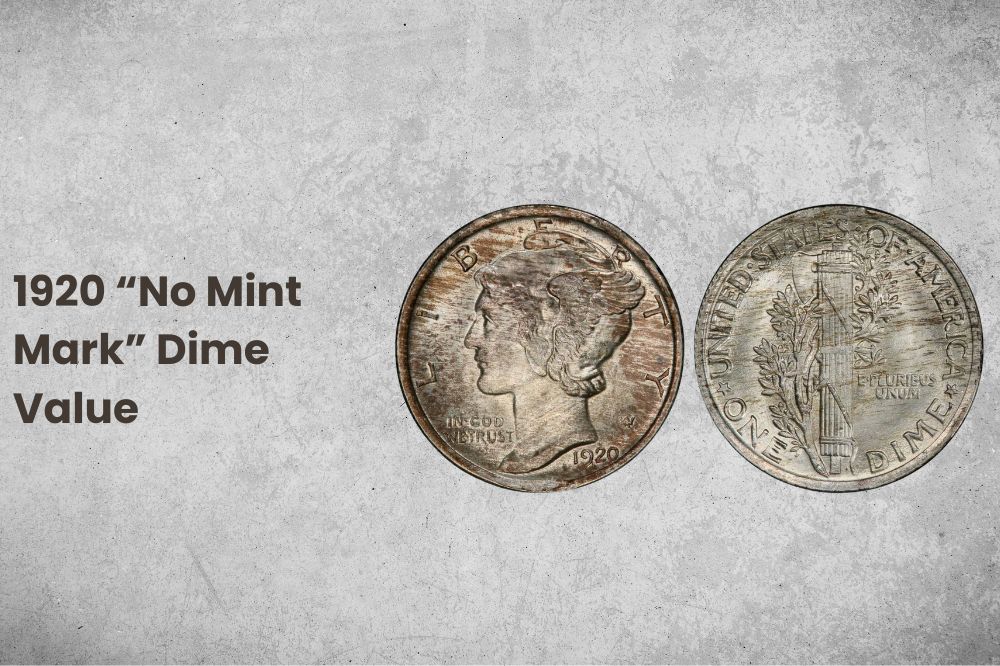
- Type: Mercury Dime
- Edge: Reeded
- Mint Mark: N/A
- Mintage: 59,030,000
- Place of Minting: Philadelphia
- Year of Minting: 1920
- Face Value: $0.10
- $ Price: $3.4 to$294
- Designer: Adolph A. Weinman
In 1920, the US mint in Philadelphia minted 59,030,000 Mercury dimes, setting a record that would not be surpassed until 20 years later.
At the time, the Philadelphia mint had not started engraving the letter P on its coins. As a result, the 1920 coins did not have any mint marks. The “P” mint mark began appearing in coins produced in Philadelphian in 1942.
Because the mint produced excessive Mercury dimes in 1920, redundancy developed, limiting the minting of the coin until well in 1923. Such a large number of coins meant that some will have issues. For example, some Mercury dimes lacked full bands.
Based on the NGC price guide, a 1920 no-mint dime costs anywhere from $3 to $22. However, pristine, mint state dimes can go for as much as $1,300.
1920 “S” Dime Value
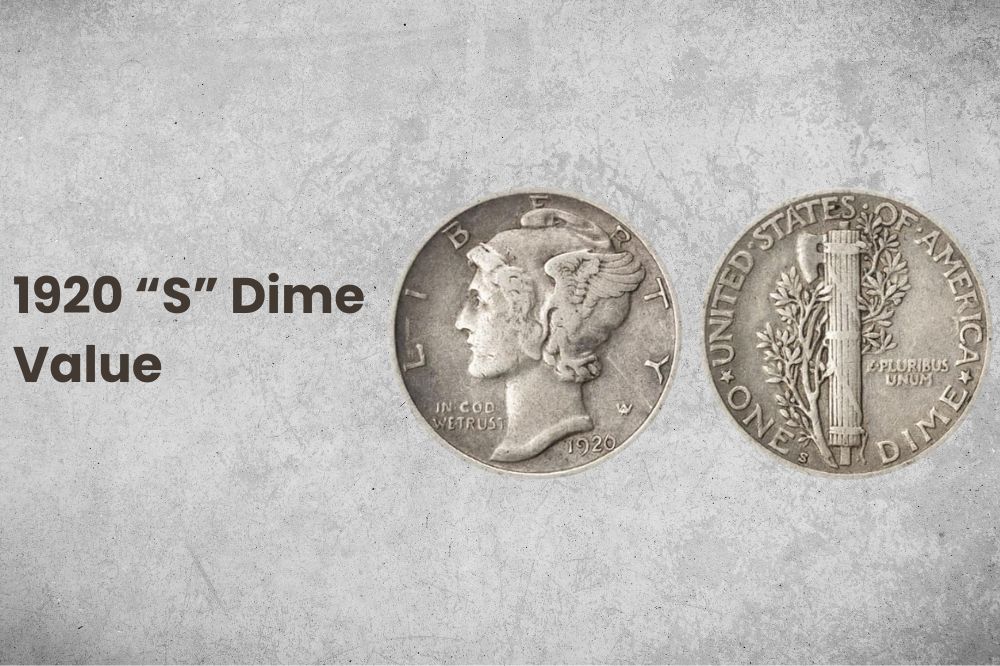
- Type: Mercury Dime
- Edge: Reeded
- Mint Mark: S
- Mintage: 13,820,000
- Place of Minting: San Francisco
- Year of Minting: 1920
- Face Value: $0.10
- $ Price: $3 to$2,000
- Designer: Adolph A. Weinman
The San Francisco mint produced over 13 million dimes in 1920. However, most 1920–S Mercury dimes remained in the mint’s vaults for some time. The mint ceased the production of this denomination until late 1923.
Most 1920–S dimes have low sticking quality since they were struck from worn-out or clashed dies. Because of this, some design elements in some dimes make them valuable. For example, 1920–S coins with both full bands and sharp dates are extremely rare, thus highly sought out and valuable.
Since most 1920 – S dimes entered circulation, uncirculated pieces are few, with gems being super rare. A 1920–S dime in good condition can cost $3. If it’s extremely fine, it can be worth between $21 to $50.
However, mint state gems in pristine condition can sell for an impressive price of $2000. In 2019, a specimen with three full bands, lovely gold, lilac toning, and a clearly defined final digit sold for $72,000.
1920 “D” Dime Value
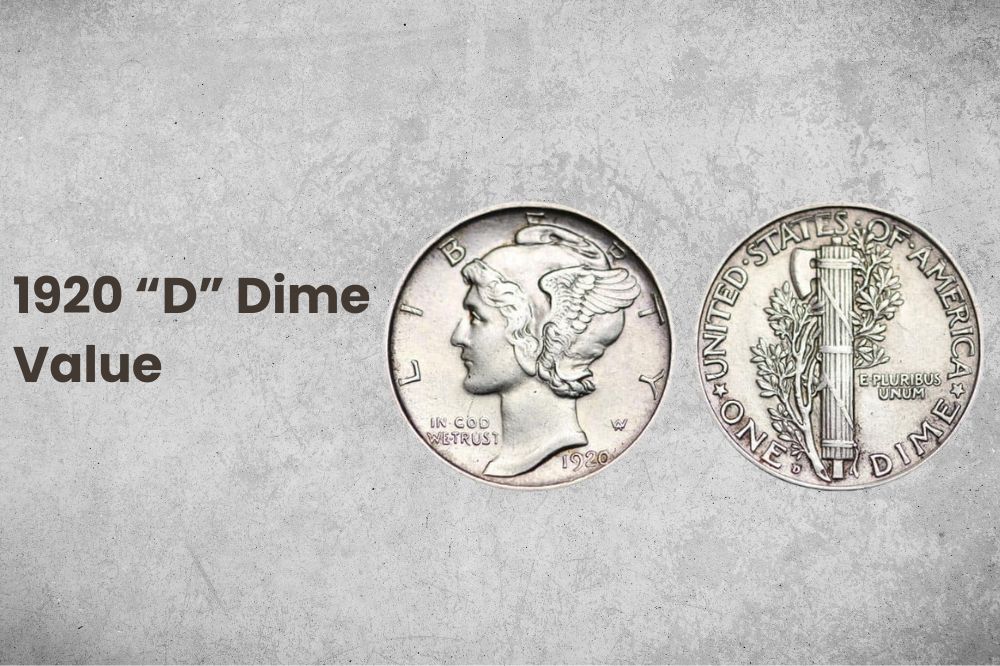
- Type: Mercury Dime
- Edge: Reeded
- Mint Mark: D
- Mintage: 19,171,000
- Place of Minting: Denver
- Year of Minting: 1920
- Face Value: $0.10
- $ Price: $3 to$3,250
- Designer: Adolph A. Weinman
The US mint in Denver struck over 19 million Mercury dimes in 1920. All the coins entered circulation, making mint-state coins rare. However, gems with full bands are quite rare and can cost several hundred dollars.
Dimes from Denver mint feature the letter “D” on the reverse side, next to the E in the denomination–ONE Cent. Most coins from this mint display some striking weakness because the die used had cracks.
Currently, a 1920–D dime costs anywhere from $3 to $3.7. Fine and extremely fine coins can sell for $4.5 and $18, respectively. As for uncirculated dimes, they can be valued from $85 to $3,250.
Also Read: Top 15 Most Valuable Roosevelt Dimes Worth Money
1920 Dime History
The Mercury dime struck from 1916 to 1945 by the US mint replaced the Barber coinage introduced in 1892. Designed by Chief Engraver–Charles E. Barber, the barber coinage series, including dime, quarter, and a half dollar, attracted considerable public dissatisfaction after their release.
For over 20 years, successful presidential administrations tried to revamp the design of these coins, but to no avail. But in 1915, the treasury decided to replace the Barber coins with a new design. The US mint held a competition, and designers submitted their designs, including Barber, who had held the position of Chief engraver for 36 years.
Adolph A. Weinman’s design for the dime, the half dollar, and the reverse quarter won the competition. On March 3, 1916, the Treasury publicly announced the new coin designs. The dime obverse showed Lady Liberty wearing a Phrygian cap with wings.
Most people confused the portrait with the Roman God Mercury and began calling it the Mercury dime. But its correct name is the Winged Liberty Head.
It’s believed the portrait of Lady Liberty used by Weinman is based on Elsie Stevens, the wife of Wallace Stevens, a poet, and lawyer. But Weinman never confirmed this speculation.
Weinman combined the Phrygian cap with wings to symbolize freedom of thought. On the reverse, he included fasces to represent strength, war, and justice. It’s surrounded by a full-foliaged branch of olive to symbolize peace.
Additionally, the designer also worked on the half-dollar the same year. He also incorporated his initials in the coin’s design.
Even though the design was simple and admired by most people, the Mint made several modifications to the coin so people could use them in vending machines.
The Mercury coins remained in circulation until 1945 when the government ordered a new design. But in 2016, the coin was minted in gold for its centenary.
1920 Dime Grading
Learning how to grade your Mercury dime accurately allows you to get an idea of your coin’s potential value. The 1920 dime gets graded into several categories, including:
- Uncirculated: Most 1920 dimes got circulated. However, they are a few mint-state coins out there. Usually, these coins are well preserved and show no sign of wear and damage. As you have guessed, coin collectors will pay top dollar for the specimen.
- Extremely Fine: Such a coin show signs of wear and scratches on the surface. It is also possible they might have lightly flattened areas, especially on Lady Liberty’s portrait or fasces. Nonetheless, the engravings still show, and the design stands out.
- Fine: A fine dime features discolored and scratched surfaces. Most times, Lady Liberty’s portrait is flat, and the Phrygian cap has lost some of its feathers. Sometimes, the olive branches and full bands might appear smooth and unrecognizable.
- Good: These are heavily damaged coins with super soft surfaces. It’s even hard to determine the coin’s rim from its field. The production date and other engraving are worn-out completely and the entire surface is flat.
1920 Dime Error
Like many coins, the 1920 dime comes with some errors and variations, including:
1. 1920 Dime Broad struck Error
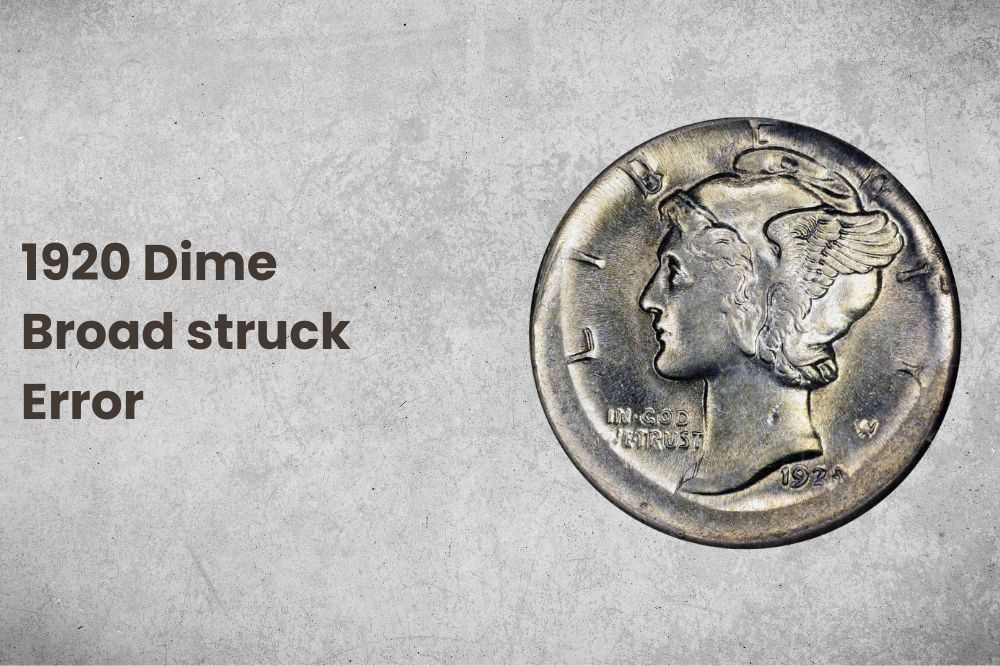
A broad struck error in 1920 dime occurs when the coin does not align properly with the striking press. As a result, the coin gets struck outside of the retaining collar (a metal ring that ensures the dime is struck with the correct diameter).
A misaligned collar means the coin will have a larger diameter. It will also be thinner compared to a normal 1920 dime. Sometimes, the specimen could miss certain elements and have a flattened or raised edge.
This error can increase the coin’s value, especially if it’s in excellent condition.
2. 1920 Dime Off Center Strike Error
Like broad struck error, the off-center error results from misalignment during the coin striking. The degree of off-center often varies, with some coins 10% off-center and others 50% off-center.
Such coins tend to fetch a high price. For example, a 13% off-center 1920 dime with mint state 64 sold for over $1,100. Another one with a 20% off-center error sold for a whopping $1800. Uncirculated coins in extra fine condition can sell for even more.
3. 1920 Dime Clipped Planchet Error
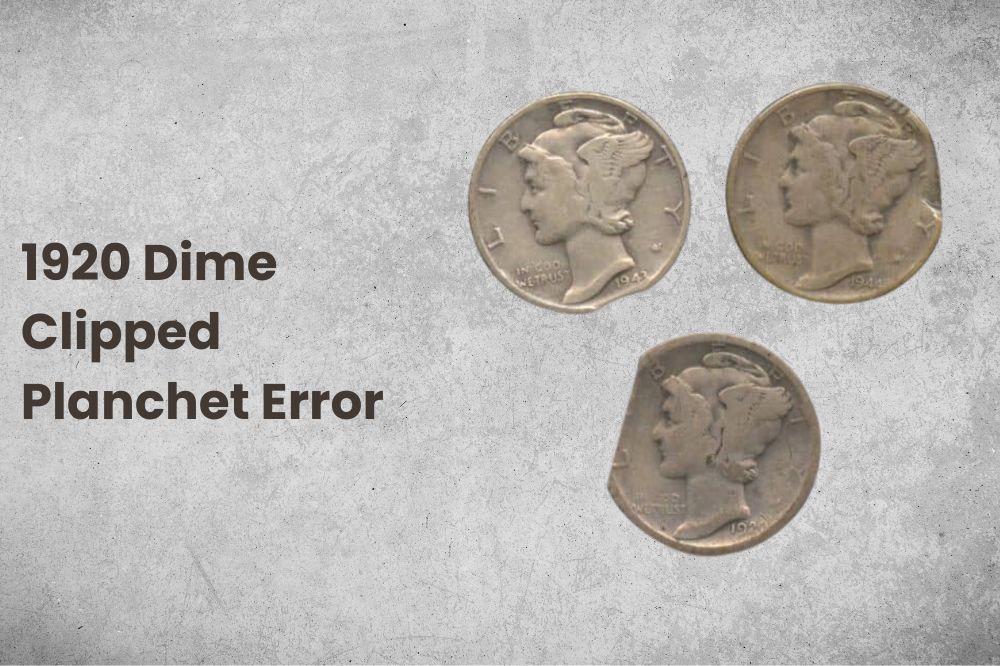
Another error worth checking out is the clipped planchet error. This error can occur when a section of the coin’s planchet (or blank metal disk) is cut or clipped off before striking. Coins with this type of error usually have an irregular shape or might have some design details, like a rim.
A coin with this error might have a small feature or miss a large portion of its design. Either way, collectors are always looking for this error in 1920 dimes. As with all errors, the coin’s value will vary depending on its state and rarity.
If you have a 1920 dime with any of these errors, we recommend you have it checked by a professional coin grading company to determine its authenticity and worth. But remember, not all errors increase the value of coins–some decrease their value.
1920 Dime FAQ
How many 1920 coins were produced?
The US mint produced a total of 92,021,000 1920 coins. The minting facility in Philadelphia minted 59,030,000 Mercury dimes. San Francisco mint produced 13,820,000 coins, and the Denver mint 19,171,000 Mercury dimes. After 1945, the Mercury dime got replaced by the Roosevelt dime.
How much is a 1920 dime worth?
1920 Mercury dime in good condition costs between $3 and $5. In excellent condition or extremely fine state, the value rises to $25. Uncirculated coins can go for upwards of $500 to $70,000. If the 1920 dime comes with an error like strike off center or broad struck, its value increases.
How do you determine the value of a 1920 dime?
Grading offers you an efficient way of determining 1920 dime value. However, consider the rarity of the coins, errors, and variation. If you do not know how to grade your dime, seek the service of a professional coin grading company and get proper estimates of its worth.
